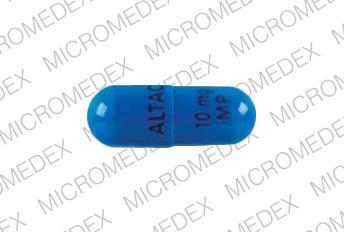Altace Dosage
Generic name: RAMIPRIL 1.25mg
Dosage form: capsule
Drug class: Angiotensin Converting Enzyme Inhibitors
Medically reviewed by Drugs.com. Last updated on Nov 28, 2023.
Hypertension
The recommended initial dose for patients not receiving a diuretic is 2.5 mg once a day. Adjust dose according to blood pressure response. The usual maintenance dosage range is 2.5 mg to 20 mg per day administered as a single dose or in two equally divided doses. In some patients treated once daily, the antihypertensive effect may diminish toward the end of the dosing interval. In such patients, consider an increase in dosage or twice daily administration. If blood pressure is not controlled with ALTACE alone, a diuretic can be added.
Reduction in Risk of Myocardial Infarction, Stroke, and Death from Cardiovascular Causes
Initiate dosing at 2.5 mg once daily for 1 week, 5 mg once daily for the next 3 weeks, and then increase as tolerated, to a maintenance dose of 10 mg once daily. If the patient is hypertensive or recently post-myocardial infarction, ALTACE can also be given as a divided dose.
Heart Failure Post-Myocardial Infarction
For the treatment of post-myocardial infarction patients who have shown signs of congestive heart failure, the recommended starting dose of ALTACE is 2.5 mg twice daily (5 mg per day). A patient who becomes hypotensive at this dose may be switched to 1.25 mg twice daily. After one week at the starting dose, increase dose (if tolerated) toward a target dose of 5 mg twice daily, with dosage increases being about 3 weeks apart.
After the initial dose of ALTACE, observe the patient under medical supervision for at least two hours and until blood pressure has stabilized for at least an additional hour. If possible, reduce the dose of any concomitant diuretic as this may diminish the likelihood of hypotension. The appearance of hypotension after the initial dose of ALTACE does not preclude subsequent careful dose titration with the drug, following effective management of the hypotension [see Warnings and Precautions (5.5), Drug Interactions (7.1)].
General Dosing Information
Generally, swallow ALTACE capsules whole. The ALTACE capsule can also be opened and the contents sprinkled on a small amount (about 4 oz.) of applesauce or mixed in 4 oz. (120 mL) of water or apple juice. To be sure that ramipril is not lost when such a mixture is used, consume the mixture in its entirety. The described mixtures can be pre-prepared and stored for up to 24 hours at room temperature or up to 48 hours under refrigeration.
Concomitant administration of ALTACE with potassium supplements, potassium salt substitutes, or potassium-sparing diuretics can lead to increases of serum potassium [see Warnings and Precautions (5.8)].
Dosage Adjustment
Renal Impairment
Establish baseline renal function in patients initiating ALTACE. Usual regimens of therapy with ALTACE may be followed in patients with estimated creatinine clearance >40 mL/min. However, in patients with worse impairment, 25% of the usual dose of ramipril is expected to produce full therapeutic levels of ramiprilat [see Use in Specific Populations (8.6)].
Hypertension
For patients with hypertension and renal impairment, the recommended initial dose is 1.25 mg ALTACE once daily. Dosage may be titrated upward until blood pressure is controlled or to a maximum total daily dose of 5 mg.
Heart Failure Post-Myocardial Infarction
For patients with heart failure and renal impairment, the recommended initial dose is 1.25 mg ALTACE once daily. The dose may be increased to 1.25 mg twice daily, and up to a maximum dose of 2.5 mg twice daily depending on clinical response and tolerability.
Volume Depletion or Renal Artery Stenosis
Blood pressure decreases associated with any dose of ALTACE depend, in part, on the presence or absence of volume depletion (e.g., past and current diuretic use) or the presence or absence of renal artery stenosis. If such circumstances are suspected to be present, initiate dosing at 1.25 mg once daily. Adjust dosage according to blood pressure response.
Frequently asked questions
More about Altace (ramipril)
- Check interactions
- Compare alternatives
- Pricing & coupons
- Reviews (12)
- Drug images
- Side effects
- Dosage information
- During pregnancy
- Generic availability
- Drug class: Angiotensin Converting Enzyme Inhibitors
- Breastfeeding
- En español
Patient resources
Professional resources
Related treatment guides
Further information
Always consult your healthcare provider to ensure the information displayed on this page applies to your personal circumstances.


